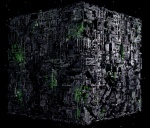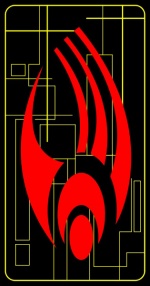Borg: Difference between revisions
From Star Trek: Theurgy Wiki
Auctor Lucan (talk | contribs) No edit summary |
Auctor Lucan (talk | contribs) No edit summary |
||
| Line 14: | Line 14: | ||
Borg were extremely strong and resilient, owing to their technologically-enhanced physiology. They lack self-determination and intuition, relying on directives and | Borg were extremely strong and resilient, owing to their technologically-enhanced physiology. They lack self-determination and intuition, relying on directives and | ||
protocols from the Collective, and the gestalt consciousness of countless other Borg drones. | protocols from the Collective, and the gestalt consciousness of countless other Borg drones. | ||
==History== | |||
Perhaps the most powerful and fearsome foe the [[Federation]] and [[Starfleet]] had ever faced, the Borg had been silent since the return of the ''[[USS Voyager]]''. The [[Federation]] had commissioned a new series of deep space probes and listening posts specifically dedicated to monitoring any possible new Borg incursion. Stafleet tended to be a step behind the Borg in most instances, so it was hoped that these probes and posts would serve as an early warning system to give the [[Federation]] a fighting chance the next time the Borg invade our space. | |||
The intelligence communities of the [[Federation]], Romulans, Klingons, and Cardassians agreed (shockingly enough) that, now that the Borg knew where they were in the galaxy and what they had to offer, they would not hesitate to come back and attempt the final assimilation of all species within the Alpha and Beta Quadrants. While the [[Federation]] had been the hardest hit during the previous Borg attacks, both the Klingons and Romulans had admitted to losses at the hands of the Borg, and there had been reports of independent peoples also suffering under the Borg. If there was one positive note to come from the past Borg attacks, it was that they had forced [[Starfleet]] engineers and scientists to get more creative with starship design. There were several new classes of [[Federation]] starships, including the Akira, Intrepid, Norway, Saber, Sovereign, and Steamrunner classes. All these ships were developed following the first Borg invasion and Battle at Wolf 359 and carried technological advances sparked in large part by the Borg threat. Hopefully, [[Starfleet]] could get enough of these new ships built, manned, and entered into service before the Borg return. | |||
[[Category:Races]] | [[Category:Races]] | ||
[http://memory-alpha.wikia.com/wiki/Borg Source: Memory Alpha & Star Trek: Adventures Core Rulebook] | [http://memory-alpha.wikia.com/wiki/Borg Source: Memory Alpha & Star Trek: Adventures Core Rulebook] | ||
Revision as of 09:43, 24 August 2018
The Borg were a pseudo-species of cybernetic beings, or cyborgs, from the Delta Quadrant. No single individual truly existed within the Borg Collective (with the exception of the Borg Queen), as all Borg were linked into a hive mind. Their ultimate goal was the attainment of 'perfection' through the forcible assimilation of diverse sentient species, technologies, and knowledge. As a result, the Borg were among the most powerful and feared entities in the galaxy, without really being a true species at all.
After the transwarp network was destroyed by the USS Voyager in 2378, the Borg was never seen again anywhere near the Alpha Quadrant.
Physiology
Borg was not something that a person is born to, but rather something that they are forced to become — though for infants and children assimilated by the Collective, they may have little or no memory of any other life. The Borg melded biology with technology, and a drone would have countless implants, the result of both invasive surgery and aggressive nanotechnology. Therefore, the physiology of each Borg drone varied according to the species from which it was assimilated. U pon assimilation, a drone ceased to grow body hair and developed an ashen, grayish skin coloration, ignoring original skin pigmentation. Cybernetic implants were either surgically attached to the body or grown internally by nanoprobes injected into the bloodstream; in certain cases these implants could cause severe skin irritation. The nature of these implants varied from drone to drone depending on the drone's intended function, but basic nodes of interlink for communications with the Collective and a myo-neural cortical array to control movements were implemented in every drone. In most cases an eye would be replaced with an eyepiece that improved vision and an arm would be amputated altogether to make room for a functional prosthetic; in tactical drones a weapon would be included, and some drones had medical tools built in.
Borg were extremely strong and resilient, owing to their technologically-enhanced physiology. They lack self-determination and intuition, relying on directives and protocols from the Collective, and the gestalt consciousness of countless other Borg drones.
History
Perhaps the most powerful and fearsome foe the Federation and Starfleet had ever faced, the Borg had been silent since the return of the USS Voyager. The Federation had commissioned a new series of deep space probes and listening posts specifically dedicated to monitoring any possible new Borg incursion. Stafleet tended to be a step behind the Borg in most instances, so it was hoped that these probes and posts would serve as an early warning system to give the Federation a fighting chance the next time the Borg invade our space.
The intelligence communities of the Federation, Romulans, Klingons, and Cardassians agreed (shockingly enough) that, now that the Borg knew where they were in the galaxy and what they had to offer, they would not hesitate to come back and attempt the final assimilation of all species within the Alpha and Beta Quadrants. While the Federation had been the hardest hit during the previous Borg attacks, both the Klingons and Romulans had admitted to losses at the hands of the Borg, and there had been reports of independent peoples also suffering under the Borg. If there was one positive note to come from the past Borg attacks, it was that they had forced Starfleet engineers and scientists to get more creative with starship design. There were several new classes of Federation starships, including the Akira, Intrepid, Norway, Saber, Sovereign, and Steamrunner classes. All these ships were developed following the first Borg invasion and Battle at Wolf 359 and carried technological advances sparked in large part by the Borg threat. Hopefully, Starfleet could get enough of these new ships built, manned, and entered into service before the Borg return. Source: Memory Alpha & Star Trek: Adventures Core Rulebook



